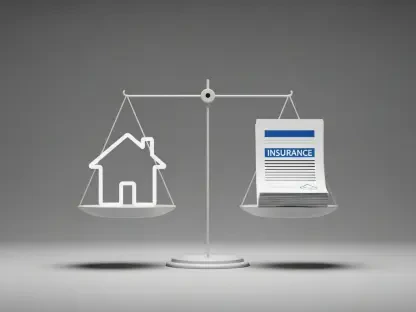Unveiling a Hidden Threat in Home Safety
Picture a devastating fire tearing through a home, leaving behind not just charred remains but also a shocking financial blow: an insurance claim denied due to a missing or malfunctioning smoke alarm. This scenario is far from hypothetical, as millions in claims hang in the balance across the US due to overlooked safety measures. With an estimated $20 million in home insurance claims at risk, the intersection of fire safety and insurance validity has become a critical market concern. This analysis delves into the trends shaping this issue, exploring how the absence of operational smoke alarms impacts both homeowners and insurers. By examining current data, emerging patterns, and future projections, the goal is to illuminate the stakes and provide strategic insights for stakeholders navigating this complex landscape.
Dissecting the Market: Trends and Data Insights
Alarming Statistics Reveal a Safety Crisis
The home safety market is grappling with a stark reality: a significant portion of dwelling fires occur in properties without working smoke alarms. Data compiled from multiple authoritative sources for the year ending March 2024 indicates that approximately 13,458 fires attended by fire and rescue services took place in US homes lacking functional detectors. This figure represents a substantial 43% of all dwelling fires in the country during that period, underscoring a pervasive gap in safety compliance. Even more troubling, over half of fire-related fatalities—52%—were linked to homes without operational alarms, highlighting the dire human cost of this oversight. These numbers signal a pressing need for market interventions to address both safety and financial vulnerabilities.
Consumer Awareness: A Barrier to Compliance
Beyond the raw data lies a deeper challenge within the market: a widespread lack of consumer awareness about the insurance implications of smoke alarm neglect. Surveys reveal that 62% of US residents remain unaware that failing to regularly test their alarms could invalidate insurance claims. Furthermore, about 1% of the population—equating to roughly 3.3 million individuals—report having no smoke detector installed at all. This knowledge gap creates a ripple effect, as homeowners often discover their exposure only after a catastrophic event. Compared to other household safety practices, such as securing windows or installing locks, the underestimation of smoke alarm importance stands out as a critical market blind spot, necessitating targeted education efforts.
Insurance Sector Challenges: Claims and Costs
From an insurance market perspective, the absence of working smoke alarms introduces significant underwriting and operational hurdles. Policies frequently include clauses mandating functional detectors as a prerequisite for claim validity, yet variations in policy language across providers create confusion for policyholders. When claims are denied due to non-compliance, the financial burden shifts to homeowners, with repair costs often soaring into tens of thousands of dollars. Additionally, such denials lead to disputes, delayed settlements, and heightened administrative expenses for insurers, while also risking reputational damage, especially when vulnerable customers are involved. This dynamic reveals a market tension between enforcing safety standards and maintaining customer trust, pushing insurers to seek innovative solutions.
Projecting Forward: Emerging Solutions and Market Shifts
Technological Innovations Reshaping Safety Standards
Looking toward the horizon, the home safety and insurance markets are poised for transformation through technological advancements. Smart smoke detectors, capable of sending real-time alerts to both homeowners and insurers, are gaining traction as a tool to reduce disputes over functionality. These devices offer verifiable evidence of compliance, potentially streamlining claims processes and minimizing losses. As adoption grows, projections suggest that smart technology could become a standard expectation within the next few years, particularly if integrated with insurance incentives like premium discounts. This trend points to a market evolution where prevention and digital monitoring converge to enhance safety outcomes.
Regulatory and Industry Collaboration on the Rise
Alongside technology, regulatory pressures are shaping the future of this market. There is increasing momentum for stricter mandates on smoke alarm installation and maintenance, which could be tied directly to insurance underwriting criteria. Industry stakeholders are also exploring collaborative frameworks to align safety standards with policy terms, reducing ambiguity for consumers. Economic factors, such as rising post-fire repair costs, further incentivize insurers to prioritize prevention over payouts, potentially leading to new market offerings that reward compliant households. This shift suggests a future where regulatory and industry efforts work in tandem to mitigate risks and foster a culture of proactive safety.
Consumer Behavior as a Market Driver
A critical factor in future market dynamics will be consumer behavior and the extent to which awareness campaigns can drive compliance. Current trends indicate a slow but growing recognition of the stakes involved, yet the pace of change remains insufficient to close existing gaps. Projections for the coming years, starting from now through 2027, anticipate that sustained educational initiatives could increase smoke alarm adoption and maintenance rates by a notable margin. However, success hinges on multi-stakeholder engagement, including insurers clarifying policy expectations and local authorities promoting accessible safety resources. This behavioral shift could redefine market risk profiles, ultimately benefiting both policyholders and providers.
Reflecting on the Analysis: Strategic Takeaways
Looking back on this market analysis, it becomes evident that the intersection of smoke alarms and home insurance represents a multifaceted challenge with profound implications for safety and financial stability. The data paints a sobering picture, with thousands of fires and significant fatalities tied to non-functional detectors, while consumer unawareness compounds the risks. Insurers face their own struggles, balancing compliance enforcement with customer relations amid rising costs and disputes. Moving forward, strategic actions emerge as essential: homeowners are encouraged to adopt routine alarm testing and consider smart technology upgrades to safeguard claims. Insurers, meanwhile, need to prioritize transparent communication and explore partnerships for innovative safety solutions. Ultimately, the path ahead calls for a collective commitment to prevention, ensuring that both lives and livelihoods are protected through sustained market evolution.









